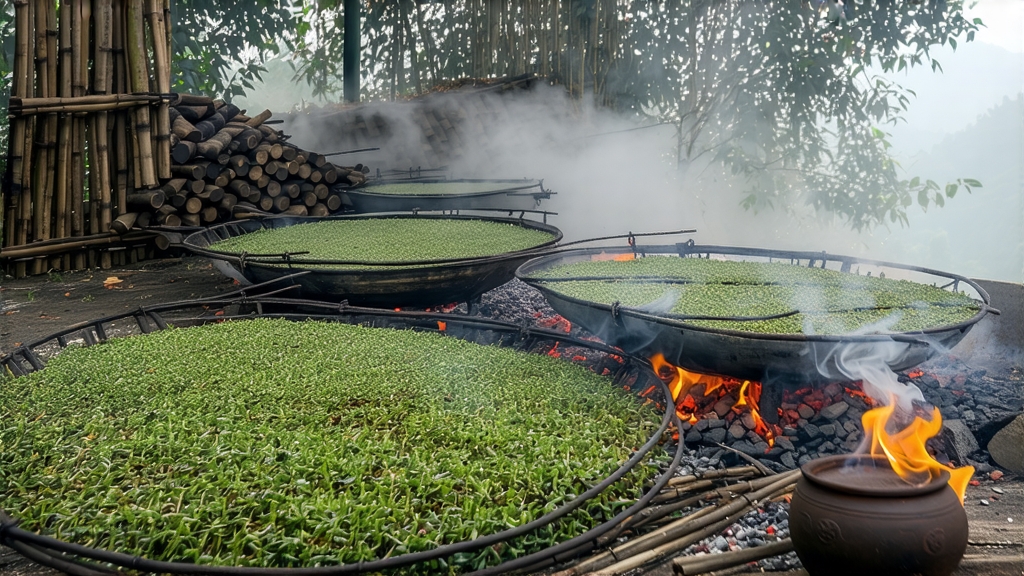
Lapsang Souchong—known in China as Zheng Shan Xiao Zhong—occupies a singular throne in the pantheon of black teas. It is simultaneously the oldest recorded black tea in world history and the most polarizing, celebrated for its fragrant curl of pine smoke that can evoke both a cozy campfire and an elegant cigar. To understand this tea is to travel into the volcanic heart of the Wuyi Mountains in northern Fujian Province, where cliffs press against rivers and morning mist clings to the canopy like silk. Here, in the original protected zone of Tongmu Guan, the story of fully oxidized tea began almost four centuries ago, long before the Assam and Ceylon gardens ever existed.
Historical records from the Ming Dynasty (1368-1644) first mention “black tea” in 1610, when caravans carried compressed leaves from the Wuyi trading post of Xingcun to the port of Quanzhou, then onward to Java and the Netherlands. Dutch merchants christened the cargo “bohea,” a corruption of “Wuyi,” and Europe’s love affair with strong red liquor was born. Local lore insists that Lapsang Souchong’s smoky character was an accident: Qing-era soldiers, so the tale goes, commandeered a tea factory during harvest, forcing farmers to dry the leaves hastily over fresh pine fires so they could meet market deadlines. Whether myth or marketing, the technique endured, refined by monks and merchants into the guarded protocol still observed today.
True Zheng Shan Xiao Zhong is made only from a narrow range of indigenous cultivars—Xiao Ye Zhong (small-leaf), Da Bai Ye (big white leaf), and the newly selected Wuniu Zao—grown between 600 and 1,200 m on weathered tuff soil. The cool, humid microclimate slows growth, concentrating amino acids and volatile aromatics. Leaves are picked in the brief window from late April to early May, when two leaves and a bud still wear their downy silver cloak. Unlike many black teas, Lapsang Souchong allows slightly larger, more mature leaves; their thicker cell walls withstand the rigorous smoking stage without collapsing into dust.
Withering begins on bamboo trays set in the second-floor lofts of wooden factories built over rushing streams. Here, pine and cedar logs smolder in shallow pits, sending a cool, aromatic smoke upward through slatted floors. Over six to eight hours the leaf loses about 65 % of its moisture while absorbing phenols and creosols that will later polymerize into signature notes of longan, resin, and smoked lychee. Master witherers shuffle trays every twenty minutes, ensuring each leaf “breathes” evenly; too much smoke at this stage produces a harsh, kerosene edge, too little and the tea tastes hollow.
Once withered, leaves are rolled by machine or, for the highest grades, by hand on rattan mats. The rolling action ruptures cell walls, releasing enzymes and juices that initiate oxidation. In Tongmu Guan, oxidation is still carried out in the same pine-paneled chambers used for withering; the lingering smoke forms a micro-aerosol that drifts across the leaf piles, adding a whisper of terroir impossible to replicate elsewhere. Temperature is held at 24–26 °C with 80 % humidity for roughly three hours, until the leaf turns a uniform mahogany and the aroma shifts from grassy to baked sweet potato.
Firing halts oxidation and locks in flavor. Traditional baskets made from galvanized wire are suspended over a slow fire of local Masson pine; the wood is split to finger-thickness so it burns with a blue, almost invisible flame that perfumes rather than scorches. The tea is dried in three passes—first at 90 °C for twenty minutes, then 80 °C, finally 70 °C—each pass lowering moisture from 40 % to 6 %. Between passes the leaves rest, allowing internal moisture to migrate outward, preventing “case hardening.” When done correctly, the finished leaf glistens with a charcoal bloom yet crumbles softly between the fingers, releasing a scent that marries caramelized honey with pine balsam.
Modern innovations have produced an unsmoked style called “No-Smoke Lapsang,” dried with hot air rather than pine embers. This variant showcases the cultivar’s innate fruitiness—dried apricot, rosehip, and a hint of cacao—appealing to drinkers who find classic versions too assertive. Purists argue it is no longer Zheng Shan Xiao Zhong